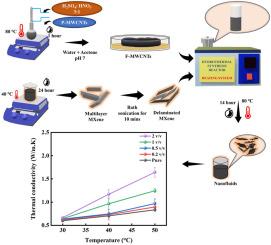混合维纳米流体:利用二维和一维材料协同增热
IF 4.3
3区 材料科学
Q2 MATERIALS SCIENCE, MULTIDISCIPLINARY
引用次数: 0
摘要
由于工作部件的磨损,汽车普遍存在发热量过大的问题。为避免汽车因产生大量热量而熄火,需要一个合适的传热系统。水和乙二醇(EG)等液体可作为冷却剂,减少产生的热量。为了进一步提高这些冷却剂的效果,可以使用纳米流体,这种流体含有分散在水、乙二醇或这两种流体混合物等基础流体中的纳米颗粒。本研究使用 Ti3C2(MXene)(二维)和功能化多壁碳纳米管(F-MWCNTs)(一维)纳米复合材料制备了混合纳米流体。利用 X 射线衍射 (XRD) 进行结构分析,利用场发射扫描电子显微镜 (FESEM)、扫描电子显微镜 (SEM) 和高分辨率透射电子显微镜 (HR-TEM) 以及能量色散 X 射线分析 (EDAX) 进行形态和元素分析,并利用傅立叶变换红外光谱 (FTIR) 鉴定官能团。通过测量热导率和粘度,测试了制备的纳米流体在传热应用中的适用性。通过 zeta 电位测量验证了纳米流体的长期稳定性。与基础流体(水)相比,在水中添加分散剂可提高导热率(室温下约为 10.83%,50 ℃ 时约为 96.76%),同时降低粘度,从而证实了纳米流体在传热应用中的适用性。本文章由计算机程序翻译,如有差异,请以英文原文为准。

Mixed-dimensional nanofluids: Synergistic thermal enhancement using 2D and 1D materials
Excessive heat generation is a common problem in automobiles due to wear and tear of working parts. A suitable heat transfer system is required to avoid stalling automobiles due to the large quantity of heat generated. Liquids like water and ethylene glycol (EG) serve as a coolant by reducing generated heat. To further increase the effectiveness of these coolants, nanofluids which contain nanosized particles dispersed in base fluid like water, ethylene glycol, or a mixture of these two, can be used. In the present work, hybrid nanofluids using Ti3C2 (MXene) (2D) and functionalized multi-wall carbon nanotubes (F-MWCNTs) (1D) nanocomposites are prepared. The prepared material is characterized using X-ray diffraction (XRD) for structural analysis, field emission scanning electron microscopy (FESEM), scanning electron microscopy (SEM), and high-resolution transmission electron microscopy (HR-TEM) with energy dispersive X-ray analysis (EDAX) for morphological and elemental analysis, and Fourier transform infrared spectroscopy (FTIR) for identifying functional groups. The suitability of the prepared nanofluids is tested for heat transfer application by measuring the thermal conductivity and viscosity. The long-term stability of the nanofluids is verified by zeta potential measurement. The addition of the dispersant to the water has shown an enhanced thermal conductivity (about 10.83% at room temperature and 96.76% at 50 °C) while having lower viscosity compared to the base fluid (water), confirming the suitability for heat transfer applications.
求助全文
通过发布文献求助,成功后即可免费获取论文全文。
去求助
来源期刊

Materials Chemistry and Physics
工程技术-材料科学:综合
CiteScore
8.70
自引率
4.30%
发文量
1515
审稿时长
69 days
期刊介绍:
Materials Chemistry and Physics is devoted to short communications, full-length research papers and feature articles on interrelationships among structure, properties, processing and performance of materials. The Editors welcome manuscripts on thin films, surface and interface science, materials degradation and reliability, metallurgy, semiconductors and optoelectronic materials, fine ceramics, magnetics, superconductors, specialty polymers, nano-materials and composite materials.
 求助内容:
求助内容: 应助结果提醒方式:
应助结果提醒方式:


